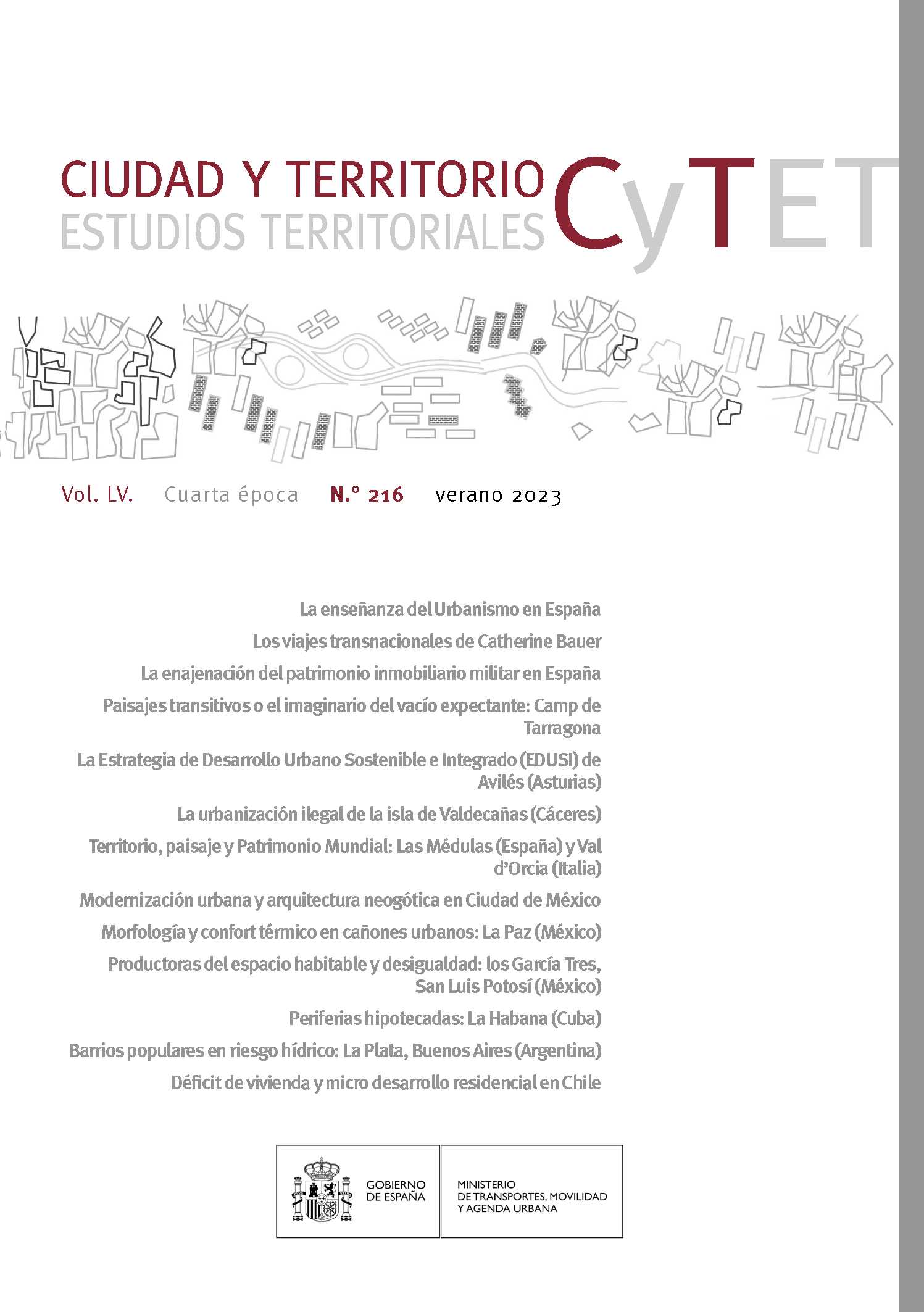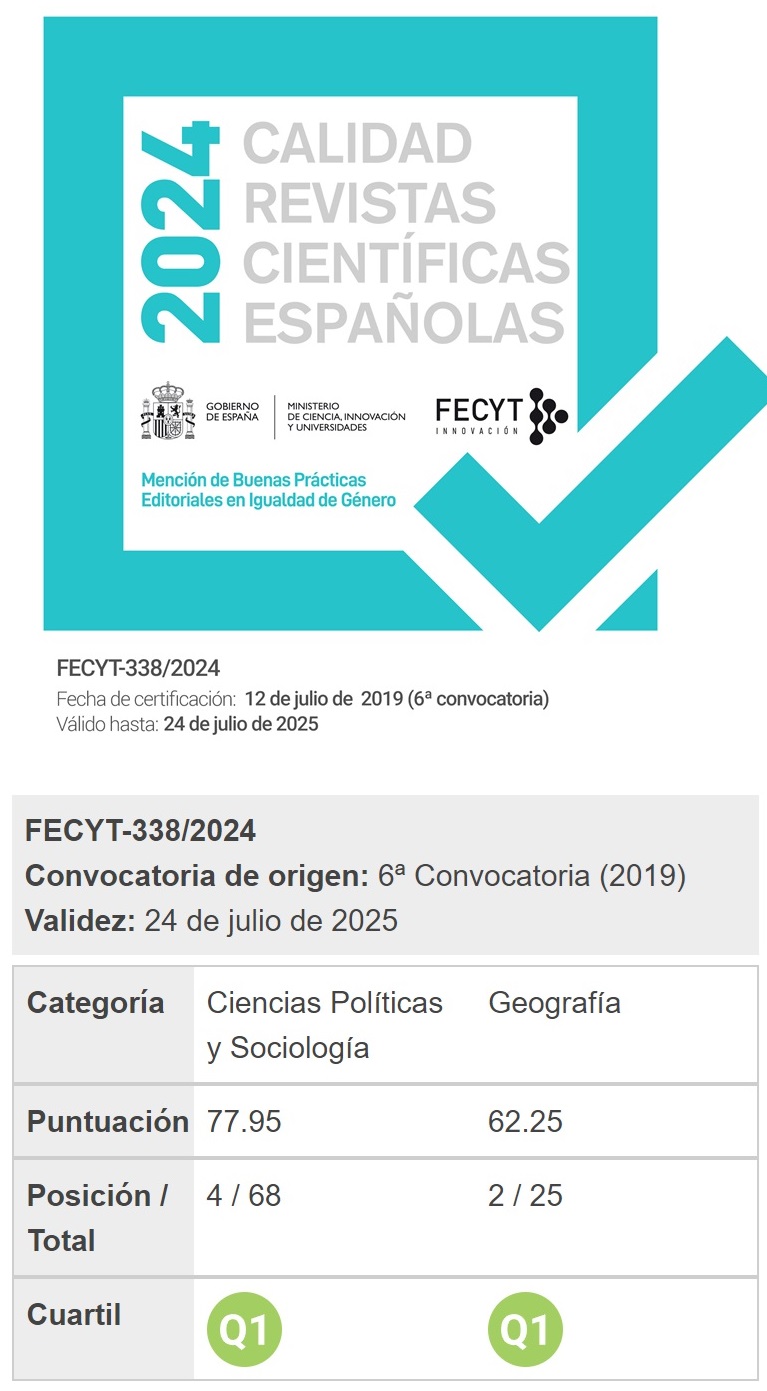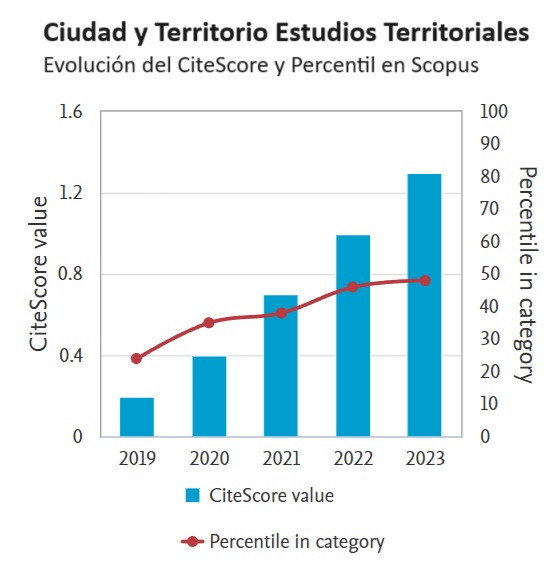La enajenación del patrimonio inmobiliario militar en España: una aproximación en torno a las cuestiones de regeneración urbana
DOI:
https://doi.org/10.37230/CyTET.2023.216.3Palabras clave:
Instalaciones militares, Abandono, Mercado inmobiliario, Política urbanaResumen
La investigación contextualiza las políticas de enajenación de los bienes inmuebles afectados al Ministerio de Defensa español y argumenta las oportunidades e inercias para llevar a cabo una efectiva reutilización de dichos bienes. El trabajo, pone énfasis en los resultados de los procesos de enajenación que paulatinamente se han ido produciendo en el país y que, de algún modo, pueden ser reproducibles en otros contextos internacionales a través de la correspondiente legislación e interés inmobiliario del organismo. Partiendo del contexto legal español se analizan dos casos de estudios, sobre los que abordar y caracterizar las principales características de los procesos de reutilización, demostrando un enfoque prevalentemente especulativo por parte del Ministerio de Defensa a la hora de plantear las operaciones de enajenación de estos bienes.
Descargas
Citas
Adisson, F. (2018): From state restructuring to urban restructuring: the intermediation of public landownership in urban development projects in France. European Urban and Regional Studies, 25(4): 373-380. https://doi.org/10.1177%2F0969776417717308
Adisson, F. & Artioli, F. (2020): Four types of urban austerity: Public land privatisations in French and Italian cities. Urban Studies, 57(1), 75‒92. https://doi.org/10.1177/0042098019827517
Aenka, J.& Pernica, B., & Kofro, J. (2021): The Geography of Demilitarisation: Do Regional Economic Disparities Affect the Spatial Distribution of Military Base Closures? Moravian Geographical Reports, 29(4), 252-266. https://doi.org/10.2478/mgr-2021-0018
Alvargonzález Rodríguez, R. (2001): Los nuevos usos terciarios de las propiedades militares en Asturias. Actas del VI Coloquio de Geografía del Turismo, Ocio y Recreación y del VI Coloquio de Geografía Urbana. Turismo y ciudad, Las Palmas.
Azanza López, J. J. (2010): De ensanche militar a “city” de Pamplona:arquitectura y urbanismopara una nueva imagen de la ciudad. http://www.culturanavarra.es/uploads/files/02_ Azanza_249_web.pdf
Artioli, F. (2021): Sale of public land as a financing instrument. The unspoken political choices and distributional effects of land-based solutions. Land Use Policy, 104, (105199). https://doi.org/10.1016/j.landusepol.2020.105199
Bagaeen, S. & Clark, C. (Eds.) (2016): Sustainable Regeneration of Former Military Sites, Londres-Nueva York, Reino Unido-Estados Unidos, Routledge.
Brandis, D.& Canosa, E.& Mollá, M.& Rodríguez, I. & Sáez, E. (2005): La reconversión del espacio militar en Madrid: su reutilizaciónen los últimos veinticinco años. Ciudad y Territorio. Estudios territoriales, XXXVII, 144, 37(144), 391-412.
Calderón Calderón, B. & Ruiz Valdepeñas, H. P. (2007): El lugar del patrimonio industrial en los procesos de transformación urbana de la ruina a la explotación de las reliquias fabriles en Valladolid. Ería: Revista cuatrimestral de geografía, 72, 5-73.
Camerin, F. (2017): Programmi e progetti europei di rigenerazione urbana e riuso delle aree militari in Italia. TRIA. Territorio della Ricerca su Insediamenti e Ambiente. Rivista Internazionale di Cultura Urbanistica, 18(1): 141-156. https://doi.org/10.6092/2281-4574/5314
Camerin, F. (2022): Regenerar las áreas militares enajenadas desde finales del siglo XX hasta la actualidad: el caso italiano. Ciudad y Territorio Estudios Territoriales, 54(213), 641-664. https://doi.org/10.37230/CyTET.2022.213.7
Camerin, F. & Gastaldi, F. (Eds.) (2021): Rigenerare le aree militari dismesse. Prospettive, dibattiti e riconversioni in Italia, Spagna e in contesti internazionali, Santarcangelo di Romagna, Italia, Maggioli. https://doi.org/10.30448/UNI.916.50825
Cantera Montenegro, J. (2007): La domus militaris hispana. origen, evolución y función social del cuartel en España, Madrid, España, Ministerio de Defensa.
Cantera Montenegro, J. (2013): Ejército y urbanismo. Revista de Historia Militar, 2, 51-90.
Capel, H. (2005): La morfología de las ciudades. II. Aedes facere: técnica, cultura y clase social en la construcción de edificios, Barcelona, España, Ediciones del Serbal.
Carter, D. (Ed.) (2016): Remaking post-industrial cities: lessons from North America and Europe, Londres, Reino Unido, Routledge.
Centro Internacional de Bonn para la Conversión, BICC (1997): Study on the Re-use of Former Military Lands, Bonn, Alemania, Bonn International Center for Conversion.
Christophers, B. (2018): The New Enclosure. The appropriation of public land in neoliberal Britain, Londres, Reino Unido, Verso.
Commissione IV Difesa (1999): Le dismissioni dei beni immobili della Difesa nell’ambito della ristrutturazione delle Forze armate, Roma, Italia, XIII Legislatura.
Commissione IV Difesa (2006): Resoconto stenografico indagine conoscitiva. https://www.camera.it/_dati/leg15/lavori/stencomm/04/indag/militari/2006/1025/s000r.htm
Córdoba Hernández, R. (2016): Dictamen pericial sobre la falta de reserva de vivienda de protección, la imposibilidad de materializar la edificabilidad dentro del APR 07.09, la suficiencia y condiciones de redes de espacios libres y dotaciones que justifiquen la monetización de parte de las cesiones, sobre las condiciones de las zonas verdes reservadas dentro del ámbito, la adecuación del Estudio Ambiental Estratégico a los requisitos establecidos legalmente, y la remisión al planeamiento de la catalogación de la edificación por parte del Plan Parcial de Reforma Interior del Área de Planeamiento Remitido 07.09 “TPA Raimundo Fernández Villaverde” Distrito de Chamberí. Madrid. No publicado.
de Solà-Morales Rubió, I. (1996): Terrain vague. Quaderns d’arquitectura i urbanisme, 212, 34-43.
Dallemagne, F. (1990): Les Casernes Françaises, París, Francia, Picard.
Dekel, T. (2021): The Military-Urban Nexus: the political-economy of real-estate, development, and the military in Beer-Sheva metropolis. Critical Military Studies. https://doi.org/10.1080/23337486.2021.1921371
Dioni López, J. (2021). La España de las piscinas. Como el urbanismo neoliberal ha conquistado España y transformado su mapa político (A. Editores (ed.)).
Doak, J. (1999): Planning for the reuse of redundant Defence Estate: disposal processes, policy frameworks and development impacts. Planning Practice and Research, 14(2), 211-224. https://doi.org/10.1080/02697459915733
Dubois-Maury, J. (1998): Impacts urbains des restructurations de l’appareil militaire en France. Annales de Geographie, 599, 89-97.
Fortuna, M.& Teixeira, J. & Silva F. (2021): Gone with the Winds of Peace: The Regional Economic Effects of Military Base Downsizings and Closures. Defence and Peace Economics. https://doi.org/10.1080/10242694.2021.1921463
Gaja i Díaz, F. (2017): Urbanismo concesional. Modernización, privatización y cambio de hegemonía en la acción urbana. Ciudades, 18, 103-126. https://doi.org/10.24197/ciudades.18.2015.103-126
Gené Gil, L. & Alomar Garau, G. (2020): Son Busquets (Palma, Mallorca). Un caso de urbanismo participativo para un nuevo modelo de ciudad. En C. Llop, M. Cervera & F. Peremiquel (Eds.), IV Congreso ISUF-H: Metrópolis en recomposición: prospectivas proyectuales en el Siglo XXI: Forma urbis y territorios metropolitanos (1-18). Barcelona, España, DUOT-UPC.
Glintić, M. (2015): Revitalization of military brownfields in Eastern and Central Europe. Strani pravni život, 59(4), 123-136.
Greed, C. & Johnson, D. (2014): Planning in the UK: An Introduction, Nueva York, Estados Unidos, Palgrave Macmillan.
Hansen, K. N. (2004): The Greening of Pentagon Brownfields: Using Environmental Discourse to Redevelop Former Military Bases (Lanham: Le). Cambridge University Press (CUP). https://doi.org/10.1017/s1537592706420272
Huete García, M. Á. & Merinero Rodríguez, R. (2022): De la reconstrucción al Modelo de Desarrollo Urbano Sostenible Integrado (MDUSI): una reflexión desde la perspectiva del análisis de políticas públicas. Ciudad y Territorio Estudios Territoriales, 54(212), 283–296. https://doi.org/10.37230/CyTET.2022.212.1
Hyötyläinen, M. & Haila, A. (2018): Entrepreneurial public real estate policy: The case of Eiranranta, Helsinki, Geoforum, 89, 137-144. https://doi.org/10.1016/j.geoforum.2017.04.001
Insolera, I. (1989): Insediamenti militari e trasformazioni urbane. En G. ANTONELLI & R. GRISPO (Eds.), Esercito e città. Dall’Unità agli anni Trenta. Vol. II (pp. 663-676). Roma, Italia, Ministero per i beni culturali e ambientali.
Kádár, K. (2014): The rehabilitation of former soviet military sites in Hungary. Hungarian Geographical Bulletin, 63(4), 437-456. https://doi.org/10.15201/hungeobull.63.4.5
Komarek, T. M., & Wagner, G. A. (2021): Local Fiscal Adjustments from Depopulation: Evidence from the Post-Cold War Defense Contraction. SSRN Electronic Journal, 74(1), 9-43. https://doi.org/10.2139/ssrn.3410471
López Pineiro, S. (2020): A Glossary of Urban Voids, Berlín, Alemania, Jovis.
Lloret Piñol, M. (2000): El cuartel de Lepanto. Biblio 3w. Revista bibliográfica de Geografía y Ciencias Sociales, 214, http://www.ub.edu/geocrit/b3w-214.htm
Lloret Piñol, M. (2001): La modernización del sistema de acuartelamiento en la ciudad de Barcelona: del derribo de las murallas (1854) a la Guerra Civil de 1936. Scripta Nova. Revista Electrónica de Geografía y Ciencias Sociales, 84. http://www.ub.edu/geocrit/sn-84.htm
Lozano Muñoz, A. (2008): La gestión del suelo militar desafectado, Madrid, España, Ministerio de Defensa.
Mas Hernández, R. (2003): La Presencia militar en las ciudades: orígenes y desarrollo del espacio urbano militar en España (Universidad Autónoma de Madrid (ed.)). Los Libros de la Catarata.
Morar, C. & al. (2021): Heritage, Culture and Regeneration of the Former Military Areas in the City of Oradea, Romania. Architektúra & urbanizmus, 55, 1-2, 76-87. https://doi.org/10.31577/archandurb.2021.55.1-2.6
Muro Morales, J. I. (1990): Las transformaciones en los usos de las propiedades militares en España. Finisterra, 25(50), 261-298.
Navajas Zubeldia, C. (2004): La profesionalización de las Fuerzas Armadas durante la primera legislatura popular. Historia del presente, 4, 184-209.
Orueta, F. & Fainstein, S. (2008): The new mega-projects: genesis and impacts. International Journal of Urban and Regional Research, 32(4), 759–767. https://doi.org/10.1111/j.1468-2427.2008.00829.x
OSCE (1990): Treaty on Conventional Armed Forces in Europe. http://www.osce.org/library/14087?download=tru
Perić, A., & Miljuš, M. (2021): The regeneration of military brownfields in Serbia: moving towards deliberative planning practice?. Land Use Policy, 102, 105222. https://doi.org/10.1016/j.landusepol.2020.105222
Ponzini, D. (2008): La valorizzazione degli immobili statali come opportunità di sviluppo territoriale/Public real estate appreciation as a local development opportunity. Urbanistica, 136, 87-94.
Ponzini, D. & Vani, M. (2014): Planning for military real estate conversion: collaborative practices and urban redevelopment projects in two Italian cities. Urban Research & Practice, 7(1), 56-73. https://doi.org/10.1080/17535069.2014.885743
Pradilla Cobos, E. (1990): Las Políticas Neoliberales y la Cuestión Territorial. Cuadernos de Economía, 14, 115-140.
Riechmann Fernández, J. & Taibo Arias, C. & Fernández Durán, R. & Puleo, A. H. & Alguacil Gómez, J. & Hernández Aja, A. & Rois, C. & Zamarra, C. & López García, D. & Llistar Bosch, D. & Romano Mozo, D. & Pérez, E. & Gómez-Baggethun, E. & Aneiros Vivas, E. & Cembranos Díaz, F. & Castejón Magaña, F. & Tarafa Orpinell, G. & Barcena Hinojal, I. & Barajas, J. S. & Herrero López, Y. (2009): Claves del ecologismo social. Libros en Acción / Ecologistas en Acción.
Romero González, J.& Brandis, D. & Melo, C. (2015). El giro neoliberal de las políticas para la ciudad en España. Balance a partir de los ejemplos de Madrid y Valencia. Boletín de la Asociación de Geógrafos Españoles, 69. https://doi.org/10.21138/bage.1901
Sánchez Pingarrón, J. (2018): Orígenes y desarrollo de la política de enajenación de infraestructuras militares en España. La reconversión de espacios militares para uso universitario, Madrid, España, UNED.
Sebastián Maestre, J. A. (1992): Planimetría del cuartel español del siglo XIX. Anuario del Departamento de Historia y Teoría del Arte, 4, 261–272.
Sepúlveda, I. & Bacas, R. (Eds.) (2008): El Ministerio de Defensa. Creación, desarrollo y consolidación, Madrid, España, Instituto Universitario General Gutiérrez Mellado-UNED.
Socoloff, I. & al. (2020): Estrategias de disposición del suelo público: mercantilización e inflexiones del neoliberalismo urbano en Ciudad de Buenos Aires (2015-2018). Territorios, 43, 1-24. https://doi.org/10.12804/revistas.urosario.edu.co/territorios/a.7286
Schönig, B. & Schipper, S. (Eds.) (2016): Urban Austerity: Impacts of the Global Financial Crisis on Cities in Europe, Berlín, Alemania, Theater der Zeit.
Touchton, M., & Ashley, A. J. (2019): Salvaging Community. How American Cities Rebuild Closed Military Bases. Cornell University Press; Illustrated edición.
Trevor, M. (2002): Military Barracks, Londres, Reino Unido, Shire Books
Trucy, F. & Boulaud, D. (2010): Rapport d’information fait au nom de la commission des finances (1) et de la commission des affaires étrangères, de la défense et des forces armées (2) sur la politique immobilière du ministère de la defense. https://www.senat.fr/rap/r09-503/r09-5031.pdf
Valdés Menéndez, Á. (2015): El Taller de Precisión de Artillería. https://madridciudadaniaypatrimonio.org/sites/default/files/blog/Informe_registradoBAJA.pdf
Whiteside, H. (2019): The state’s estate: Devaluing and revaluing ‘surplus’ public land in Canada. Environment and Planning A: Economy and Space, 51(2), 505–526. https://doi.org/10.1177/0308518X17723631
Zentelis, R. & Hubbard, P. & Lindenmayer, D. & Roberts, D. & Dovers, S. (2020): More bang for your buck: Managing the military training and environmental values of military training areas. Environmental and Sustainability Indicators, 8, 100053. https://doi.org/10.1016/j.indic.2020.100053
Publicado
Cómo citar
Número
Sección
Licencia
Derechos de autor 2023 Federico Camerin, Rafael Córdoba Hernández

Esta obra está bajo una licencia internacional Creative Commons Atribución-NoComercial-SinDerivadas 4.0.
Sin perjuicio de lo dispuesto en la legislación vigente sobre Propiedad Intelectual, y conforme a la misma, el/la los/las autor/a/es/as que publiquen en CyTET cede/n a título gratuito, de modo no exclusivo y sin límite temporal al Ministerio de Transportes, Movilidad y Agenda Urbana los derechos para difundir, reproducir, comunicar y distribuir en cualquier formato actual o futuro, en papel o electrónico, la versión original o derivada de su obra bajo licencia de Creative Commons Reconocimiento-NoComercial-SinObraDerivada 4.0 Internacional (CC BY-NC-ND 4.0), así como para incluir o ceder a terceros la inclusión de su contenido en índices, repositorios y bases de datos nacionales e internacionales, con referencia y reconocimiento en todo caso de la autoría del mismo.
Además, al realizar el envío, el/la los/las autor/a/es/as declara/n que se trata de un trabajo original en el que se reconocen las fuentes que han sido utilizadas en su estudio, comprometiéndose a respetar la evidencia científica y a no modificar los datos originales para verificar o refutar una hipótesis de partida; que el contenido esencial del mismo no ha sido publicado previamente ni se publicará en ninguna otra obra o revista mientras esté en proceso de evaluación en la revista CyTET; y que no se ha remitido simultáneamente a otra publicación.
Los autores deben firmar un Formulario de Cesión de Derechos, que les será enviado desde la Secretaría de CyTET una vez se acepte su artículo para ser publicado.
Con el objetivo de favorecer la difusión del conocimiento, CyTET se adhiere al movimiento de revistas de Open Access (OA) y entrega la totalidad de sus contenidos a diversos índices, repositorios y bases de datos nacionales e internacionales bajo este protocolo; por tanto, la remisión de un trabajo para ser publicado en la revista presupone la aceptación explícita por parte del autor/a de este método de distribución.
Se anima a las/os autoras/es a reproducir y alojar sus trabajos publicados en CyTET en repositorios institucionales, páginas web, etc. con la intención de contribuir a la mejora de la transferencia del conocimiento y de la citación de dichos trabajos.








 Enlace a CyTET en Linkedin
Enlace a CyTET en Linkedin